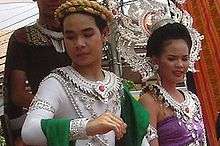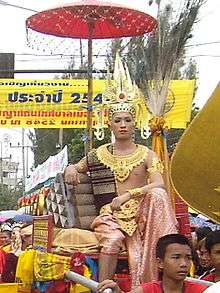Nong Han Kumphawapi Lake
| Nong Han Kumphawapi Lake | |
|---|---|
| Location | Udon Thani Province, Thailand |
| Coordinates | 17°10′N 103°02′E / 17.167°N 103.033°ECoordinates: 17°10′N 103°02′E / 17.167°N 103.033°E |
| Primary inflows | Huai Phai Chan Yai |
| Primary outflows | Lam Pao |
| Basin countries | Thailand |
| Max. length | 7 km (4.3 mi) |
| Max. width | 3 km (1.9 mi) |
| Surface area |
1.7 km2 (0.66 sq mi) (including wetland 4.1 km2 (1.6 sq mi)) |
| Average depth | 1.9 m (6 ft 3 in) |
| Surface elevation | 170 m (560 ft) |
Nong Han Kumphawapi (Thai: หนองหานกุมภวาปี, pronounced [nɔ̌ːŋ hǎːn kumpʰawaːpiː], often just Nong Han, lit. "goose wetland") is a lake in northeast Thailand, north of the town of Kumphawapi, Kumphawapi District, Udon Thani Province.
The lake is shallow, mostly not exceeding a depth of one meter. The open water area of 1.7 km² is surrounded by a wetland covering 4.1 km2, including paddy fields.
In 2001 the lake was declared a wetland of international importance by the Thai government.
Etymology
"Nong" (Thai: หนอง) means "swamp", "bog", or "fen". Because this one lies within the area of Amphoe Kumphawapi, it is also called Nong Han Kumphawapi. "Han" means goose, "kumpha" is Pali for "water pitcher", the Hindu zodiac name for the sign of Aquarius. "-Wapi" is Sanskrit for "pond".[1]
Folklore


According to local folklore, from the very beginning Nong Han played a part in the story of Phadaeng & Nang Ai.[2] In summary, Nang Ai was the daughter of King Kom who ruled the country of Chathida. The beauty of Nang Ai was famed far and wide — and deep. Many very much desired a royal wedding with her, and not all were men. Amongst the many who would wed Nang Ai were Prince Phadaeng, a man from another land, and Prince Pangkhii, who had wed Nang Ai in former lives but in this one was the son of Phaya Nak, the Grand Nāga who ruled the deeps. So many suitors desired to wed Nang Ai that her father staged a rocket festival competition, the winner to enjoy a royal wedding. But hopes were dashed when only rockets of her uncles made it aloft, and her father called the whole thing off. Naga Prince Pangkhii shape-shifteds into a white squirrel to spy on Nang Ai, but she espies him and had him killed by a royal hunter. Pangkhii's flesh magically transformed into meat equal to 8,000 cartloads (a metric cartload is 2,000 litres). Nang Ai and many of her countrymen ate of this tainted flesh, and Phaya Nak vowed to allow no one to remain living who had eaten of the flesh of his son. Aroused from the deeps, he and his watery myrmidons rose and turned the land into a vast swamp — of which the Nong Han is a remnant. See them fleeing at the Ancient Siam Garden of Pha Daeng-Nang Ai.
References
- ↑ Dictionary of the Royal Institute of Thailand (1982)
- ↑ Tossa, Wajuppa (1990). Phādāēng Nāng Ai : a translation of a Thai-Isan folk epic in verse. Includes bibliographical references. London and Toronto: Bucknell University Press. ISBN 0-8387-5139-3.
External links
- "Wetlands of South East Asia". ASEAN Regional Centre for Biodiversity Conservation. Archived from the original on September 28, 2007.
- Krungsri Documentary (in Thai)
- Story of Phadaeng and Nang Ai (in Thai)
- Penny, Dan; Grindrod, John; Bishop, Paul (1996). "Holocene Palaeoenvironmental Reconstruction Based on Microfossil Analysis of a Lake Sediment Core, Nong Han Kumphawapi, Udon Thani, Northeast Thailand". Asian Perspectives, 1996 - Volume 35, Number 2 (Fall). University of Hawai'i Press (Honolulu). hdl:10125/17082.
Pollen, phytolith, and charcoal analyses are presented for a Holocene lake sediment core taken from Nong Han (Lake) Kumphawapi,... Major changes appear in the record at approximately 6500 calibrated years B.P. with the establishment of permanent swamp or lake conditions at the core site and a decline in regional arboreal taxa. These changes are difficult to explain in simple climatic terms and are inconsistent with other climatic reconstructions for the region. A coincident increase in disturbance indicators in the microfossil record may reflect human activities, particularly changes to dry land vegetation through the use of fire. The technique appears to be insensitive to the development of intensive wet-rice agriculture, which almost certainly occurred during the period represented by the microfossil record.